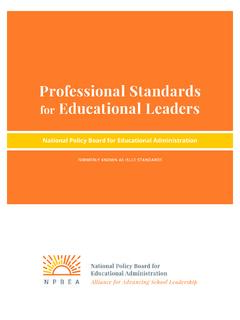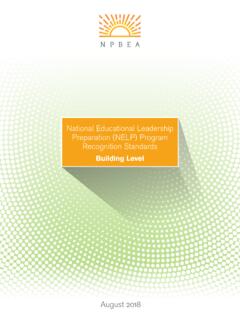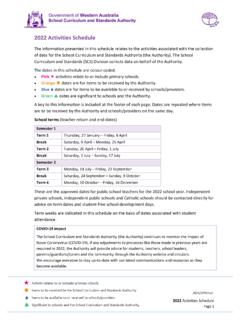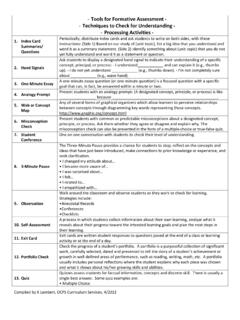Transcription of Recognition - National Policy Board for Educational ...
1 Page | 2 Educational LEADERSHIP PROGRAM Recognition Standards: Building Level For institutions undergoing NCATE Accreditation and ELCC Program Review Page | 3 For Advanced Programs at the Master, Specialist, or Doctoral Level that Prepare Assistant Principals, Principals, Curriculum Directors, Supervisors, and other Education Leaders in a School Building Environment November 2011 National Policy Board For Educational Administration (NPBEA) Page | 4 TABLE OF CONTENTS Introduction 3 ELCC Program Standard 4 ELCC Program Standard 7 ELCC Program Standard 10 ELCC Program Standard 12 ELCC Program Standard 15 ELCC Program Standard 17 ELCC Program Standard 19 Appendix 1 Assessments Description 21 Reviewer Evaluation Rubric for Standards 21 Reviewer Evaluation Rubric for Standard 22 Policies for Making Program Report Decisions 24 Appendix 2 Alignment of ELCC Program Standards with 27
2 NCATE Standard Principles Appendix 3 Commentary and Research Support for Standards 27 References 48 Appendix 4 Glossary 72 Page | 5 INTRODUCTION Rationale The importance of clearly defining what successful learning or performance looks like has become increasingly evident during the past decade. Without a doubt, the better one understands what excellence looks like, the greater one s chances are for achieving or surpassing - that standard. Ensuring effective school leadership begins with the following questions: o What do our P-12 students need to know, understand, and do?
3 O What do our teachers and related staff need to know, understand, and do to increase student learning? o What do our school building leaders need to know, understand, and do to support teachers and building-level personnel to increase student learning? Effective use of leadership preparation standards requires multiple, high integrated and highly interdependent variables and assessments. The foundation of accountability is educators understanding of the learning standards and a deep understanding of what mastery looks like. The potential value of analyzing and disaggregating student performance data is only as good as one s understanding of the learning that data represents.
4 Furthermore, while we yearn to assume alignment among standards, assessment , and instruction in addition to Policy , programs, and courses - its tremendous importance and potential impact demand ongoing attention. School leadership standards are no exception. History With the approval of the Educational Leadership Policy Standards: ISLLC 2008 ( interstate School Leaders Licensure Consortium), the NPBEA ( National Policy Board for Educational Administration) approved an ELCC ( Educational Leadership Constituent Council) plan to revise the ELCC Standards for presentation to NCATE ( National Council for the Accreditation of Teacher Education) in the fall of 2010.
5 Two groups, a Technical Advisory Committee and a Steering Committee, facilitated comprehensive research, revisions, and field review of the proposed changes prior to submitting them to NPBEA and NCATE. Assumptions The following assumptions are embedded within the ELCC school building-level leadership preparation standards: 1. Improving student achievement is the central responsibility of school leadership. 2. The standards represent the fundamental knowledge, skills, and practices intrinsic to building leadership that improve student learning.
6 3. The overall leadership standards conceptually apply to a range of common school leadership positions. They are intended to define what a building-level administrator Page | 6 should know and be able to do. While specific content and application details will vary depending upon the leadership role, the fundamental, enduring tenets are the same. 4. While there is a purposeful emphasis on leading student learning, an understanding and acceptance of school leaders responsibility for managing the business of the school is also embedded.
7 5. The practice of school leadership is well-established as its own research-based body of knowledge. 6. The preparation of school leaders requires overt connections and bridging experiences between research and practice. 7. The preparation of school leaders requires comprehensive, field-based practice in and feedback from the field over an extended period time in powerful clinical learning experiences. 8. School leadership preparation programs must provide ongoing experiences for candidates to examine, refine and strengthen the ethical platform that guides their decisions especially during difficult times.
8 9. While school leadership programs are ultimately an institutional responsibility, the strength of the design, delivery and effectiveness of these programs will parallel the degree to which higher education invites P-12 participation and feedback. 10. Performance-based measures are most effective in evaluating candidate outcomes. Implementation Improving student achievement depends on the successful and simultaneous orchestration of multiple, yet individual, variables within the context of an overall school. Given the interdependency between the execution of specific school leadership skills and the overall Educational environment, universities are expected to provide candidates with school leadership experiences that connect, embed and transcend explicit leadership skills within the context of a meaningful whole.
9 Candidates need multiple bridging experiences between course content and the school. While life in a university is compartmentalized for the convenience of instruction, life as a school leader requires the use of specialized skills within the context of often ambiguous, demanding, and interconnected events. Relentless connections to, and emphasis on, real or simulated school experiences in regard to resources, methods and assessments will greatly facilitate graduate s ultimate success as a school leader. Leadership preparation programs must include three dimensions: 1.
10 Awareness acquiring concepts, information, definitions and procedures 2. Understanding interpreting, integrating and using knowledge and skills 3. Application apply knowledge and skills to new or specific opportunities or problems The overall program should represent a synthesis of key content and high impact field-based experiences extended over time that result in the school leader candidates demonstration of the professional knowledge, skills, and dispositions articulated in the ELCC standards, and, most importantly, candidates success in improving student achievement following graduation.






